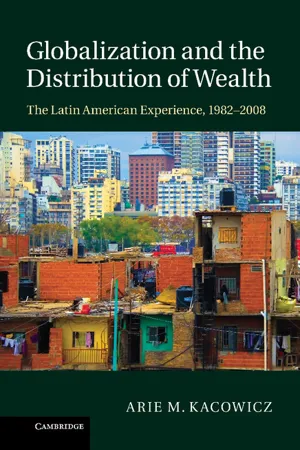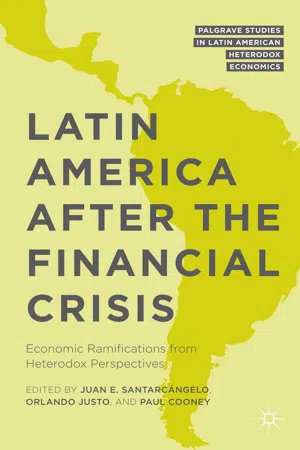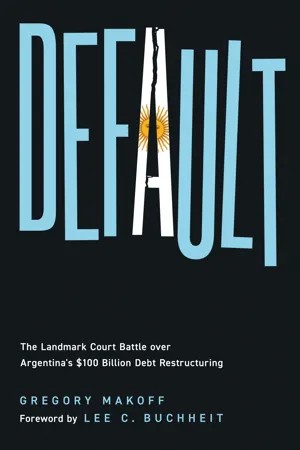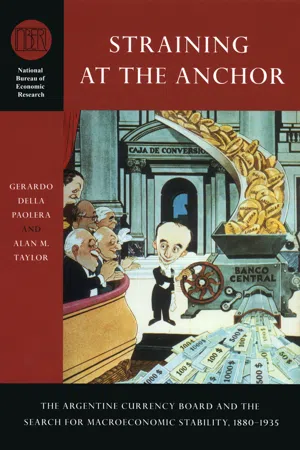Economics
Argentine Great Depression
The Argentine Great Depression refers to a severe economic crisis that occurred in Argentina between 1998 and 2002. It was characterized by a sharp decline in economic activity, high unemployment rates, and a significant devaluation of the Argentine peso. The crisis was triggered by a combination of factors including fiscal mismanagement, currency pegs, and external debt.
Written by Perlego with AI-assistance
Related key terms
1 of 5
6 Key excerpts on "Argentine Great Depression"
- Joel Horowitz(Author)
- 2008(Publication Date)
- Penn State University Press(Publisher)
To a lesser extent companies based in other countries, as well as in Argentina, joined them. The Great Depression’s full impact was not yet visible by the end of the period covered by this book; it was, however, felt. The Depression hit early: 21. Boletı ´n de servicios, April 5, 1923, 170; Di Tella and Zymelman, Las etapas del desa- rrollo, 295–355, esp. 317; Oxford Latin America Economic History Database, http://oxlad.qeh .ox.ac.uk/results.php, 9/2/2005; Pablo Gerchunoff and Lucas Llach, El ciclo de la ilusio ´n y el desencanto (Buenos Aires: Ariel, 1998), 68–74, 469; Corte ´s Conde, La economı ´a argentina, 30–33; Laura Randall, An Economic History of Argentina in the Twentieth Century (New York: Columbia University Press, 1978), 216–18; Dı ´az Alejandro, Essays, 51–53; Marı ´a Ine ´s Barbero and Fernando Rocchi, ‘‘Industry,’’ in A New Economic History of Argentina, 271–72. 22. Juan Manuel Palacio, ‘‘La antesala de lo peor: La economı ´a argentina entre 1914 y 1930,’’ in Democracia, conflicto social y renovacio ´n de ideas (1916–1930), vol. 6 of Nueva Historia Argentina, ed. Ricardo Falco ´n (Buenos Aires: Editorial Sudamericana, 2000), 115–18; Dı ´az Alejandro, Essays, 51–55; Gerchunoff and Llach, El ciclo de la ilusio ´n, 78–84; Di Tella and Zymelman, Las etapas del desarrollo, 71–101; Robert Edward Shipley, ‘‘On the Outside Looking In: A Social History of the ‘Porten ˜ o’ Worker During the ‘Golden Age’ of Argentine Develop- ment, 1914–1930’’ (Ph.D. diss., Rutgers University, 1977). 23. Comite ´ Nacional de Geografı ´a, Anuario geogra ´fico argentino 1941 (Buenos Aires: Comite ´ Nacional de Geografı ´a, 1941), 557, 560; Colin Lewis, ‘‘Economic Restructuring and Labour Scarcity: Labour in the 1920s,’’ in Essays in Argentine Labour History, 1870–1930, ed. Jeremy Adelman (London: Macmillan, 1992), 187. 22 argentina’s radical party and popular mobilization, 1916–1930 1928 had been a bad year. Employment in the capital fell slightly from August 1928 to February 1929.- eBook - PDF
Globalization and the Distribution of Wealth
The Latin American Experience, 1982–2008
- Arie M. Kacowicz(Author)
- 2013(Publication Date)
- Cambridge University Press(Publisher)
Furthermore, Brazil’s devaluation in early 1999 destroyed Argentina’s competitiveness in the foreign markets. As a result, Argentina was stuck with twin deficits, a trade gap and a budget gap, which foreigners were less and less willing and ready to finance. To right itself, the Argentine economy needed to regain competitiveness. Since the exchange rate could not fluctuate or fall (it was still fixed and pegged to the dollar), prices and wages had to fall, leading to a deep recession. As a result, peso prices edged downwards, tax revenues faltered, and Argentina’s dollar debts grew harder and harder to repay (Economist, 3 May 2005; Weintraub 2003, 109; and Williamson 2003, 5). The Argentine experience, 1982–2008 171 The Argentine case had similarities with the Brazilian crisis of 1999 in that the fallout from external events (the Asian and Russian collapses vis-` a-vis Brazil, and the Brazilian devaluation vis-` a-vis Argentina) was a major precipitating cause of what followed suit. Like a house of cards or a domino effect, this is known in the globalization literature as ‘the contagion effect of financial crises’. Yet, the Argentine case remained singular due to its overwhelming systemic (structural) dependence upon foreign capital inflows. It seems that one can find a high correlation between the direction of capital flows into emerging markets during the 1990s and the evolution of the Argentine economy (Llach 2004, 49). Thus, when these capital inflows slowed down, disappeared, or became prohibitively expensive due to both internal political and international economic events, serious economic and political problems were then created for the Argentine economy and politics, with devastating social implications in terms of poverty and inequality (Calvo 2003, 113; Weintraub 2003, 119–20; and Williamson 2003, 5). - eBook - ePub
Events That Formed the Modern World
From the European Renaissance through the War on Terror [5 volumes]
- Frank W. Thackeray, John E. Findling, Frank W. Thackeray, John E. Findling(Authors)
- 2012(Publication Date)
- ABC-CLIO(Publisher)
5 The Great Depression, 1929–c. 1939
Introduction
An economic depression is a period of substantially decreased business activity usually accompanied by high unemployment, falling wages, and declining prices. Although depressions are historically not an uncommon occurrence (there were major depressions in 1873–1878 and 1893–1897), the one that began in 1929 was so severe, long-lasting, and global in nature that it earned the name the Great Depression.After the debilitating economic upheaval caused by World War I, the world warmly welcomed the return of prosperity in the early 1920s. However, the glow of prosperity, which lasted until 1929, masked some significant economic problems. For a start, not all the world shared in this prosperity. During the 1920s, global agriculture underwent a profound crisis. Encouraged by increased demand during World War I, when much of Europe’s agricultural capacity was in limbo, farmers in such countries as the United States, Canada, Argentina, and Australia had gone deeply into debt to expand their operations. It is estimated that during the war, 33 million new acres were put under plow. With the war’s end and the resumption of normal agricultural activity in Europe, demand slumped and production grew. Above average global harvests from 1925 to 1928 aggravated the resultant overproduction. By the late 1920s, debt-ridden farmers everywhere were going bankrupt, agrarian purchasing power had virtually disappeared, the world agricultural price index, which registered 226 in 1919, now stood at 134, and the price of a bushel of wheat in terms of gold was the lowest it had been in 400 years.Furthermore, the prosperity of the late 1920s clearly rested on the export of U.S. capital and the strength of U.S. import markets. Europe was especially dependent on the United States. Beginning in 1924, a huge infusion of U.S. capital jump-started the German economy, the improvement of which subsequently sparked a general European economic upturn. Nevertheless, even before 1929, the European economy showed signs of weakening as U.S. investors shifted their resources from Europe back to the United States to take advantage of the unprecedented boom in the American stock market. However, the stock market surge was not a permanent one and, in fact, it ended abruptly. On Thursday, October 24, 1929, the U.S. stock market collapsed, setting off a spectacular panic that ultimately brought about the Great Depression. - eBook - PDF
Latin America after the Financial Crisis
Economic Ramifications from Heterodox Perspectives
- Juan E. Santarcángelo, Orlando Justo, Paul Cooney, Juan E. Santarcángelo, Orlando Justo, Paul Cooney(Authors)
- 2016(Publication Date)
- Palgrave Macmillan(Publisher)
3 The Global Crisis and Its Effects on the Accumulation in Argentina Juan E. Santarcángelo and Guido Perrone 3.1 Introduction Many economists consider the global financial crisis that started in 2007 to be the worst crisis since the Great Depression of the 1930s. Some of the immediate effects of it have been the collapse of signifi- cant financial institutions, an intense process of concentration and centralization of financial assets, and a massive injection of public resources, which tried by different means to rescue the more compro- mised commercial banks and financial institutions. The correlate of this phenomenon has been seen in the real economies of the countries that were most affected, especially the European periphery, which saw how labor market indicators worsened with the development of the crisis. Despite that historically international crisis have had significant negative effects on Latin America, the current crisis appears to have affected the countries of the region less severely. A particularly spe- cial case in this sense is Argentina, which after experiencing its worst and most dramatic economic and social crisis in 2001, has succeeded in changing the dynamics of accumulation, achieving for the period 2003–2013 the most important economic growth decade of its history. The aim of this chapter is to study the main features of the dynamics of growth experienced by Argentina in recent years, the role performed by the manufacturing sector in it, and the different 34 Juan E. Santarcángelo and Guido Perrone transmission channels of the international financial crisis on the path of growth. The chapter is divided in the following sections: the first part examines the main features of the growth process that begins after the abandonment of the convertibility regime and the contri- bution that the industrial sector made in this process. - eBook - ePub
Default
The Landmark Court Battle over Argentina's $100 Billion Debt Restructuring
- Gregory Makoff(Author)
- 2024(Publication Date)
- Georgetown University Press(Publisher)
1Argentina Defaults and Then Fights with the IMF
(December 2001–March 2003)
On December 6, 2001, the IMF pulled the plug, announcing that it was refusing to disburse a pending $1.24 billion loan installment to Argentina.1 The reason? The IMF had determined that Argentina’s finances were unsustainable. This withdrawal of official support pushed Argentina, which had already been teetering on the brink, over the edge.Within weeks, in response to draconian measures to stabilize the country’s banking system in the absence of IMF support, Argentines filled the streets screaming “they should all go,”2 Argentina’s minister of economy resigned,3 and on December 20 President Fernando de la Rúa dramatically fled, departing from the roof of the presidential palace via helicopter.4Default followed on December 23 when Adolfo Rodríguez Saá, one of the country’s three interim presidents that month, announced a moratorium on the repayment of the country’s external debt to the Argentine Congress.5 Lawmakers rose to their feet and cheered “Argentina! Argentina!”6If at the time of the default the country’s economy was in a deep freeze reminiscent of the darkest days of the Great Depression in the United States, in the new year the situation worsened. Argentina suffered from a sharp drop in economic activity, recurrent banking holidays, and sky-high unemployment.The social dimension of the crisis was enormous. Over half the Argentine population slipped below the poverty line. Crime was way up. Rioting and lawlessness ruled the streets. Those in the middle class experienced social disorder that left them shocked and disoriented. There were pickets everywhere, massive and multisectorial strikes, and no-notice raids on local supermarkets, with crowds coming out of nowhere to strip the shelves bare. An important trigger of this disorder was a breakdown of the payments system. To deal with the lack of foreign currency liquidity after the withdrawal of IMF support, the government cut access to bank accounts, which meant that middle-class families could not withdraw enough money to meet regular expenses, and there was no money to pay workers in the cash economy. The result was lines of angry depositors at banks and lines of poor people at city halls looking for handouts so they could feed their families. In a spontaneous mid-December eruption, people all over Argentina started banging pots and pans in anger, a subsequently regular form of mass protest the press called cacerolazos. And late at night Buenos Aires, the country’s beautiful capital, came to be haunted by an army of thirty thousand “cartoneros,” poor men, women, and children who collected discarded boxes just to earn enough money to buy maybe a pizza.7 - eBook - PDF
Straining at the Anchor
The Argentine Currency Board and the Search for Macroeconomic Stability, 1880-1935
- Gerardo della Paolera, Alan M. Taylor(Authors)
- 2007(Publication Date)
- University of Chicago Press(Publisher)
In this book we do not claim to offer cures for melancholy and nostalgia, nor treatment for any forms of depression (at least of the noneconomic kind). Still-in economics as in therapy-the first step is to understand the source of the ailment, even if the remaining eleven steps are a matter for other professionals. For those with a personal or historical interest in Argentina, our bookwill try to provide some answers to a question we often hear from people in various walks of life: “given its past success, how did Argentina end up like this today?” That is the puzzle. It is a simple question, without a simple answer, but it resonates all the way from our conversations with nonspecialists to controversies at the cutting edge of academic research. In recent years, theoretical and empirical work in the study of economic growth has focused heavily on concepts of long- run convergence in per capita income. Argentina offers a different lesson, an example par excellence of big-time divergence. Hence, for scholars, our study informs a continuing debate on growth, its essential economic sources and its institutional preconditions. Before us we have a rare and curious specimen: a once relatively rich country that has become relatively poor, as we shall see next in a section that looks at the cross-country evidence. In accounting for this, we do not seek to offer a monocausal explanation or even a deterministic line. Much of what has hap- pened to Argentina’s economy properly f d s under the rubric of politics, and unpredictable internal and external shocks have surely left their mark too. Our account seeks to be sensitiveto political-economyforces and cognizant ofthe oc- casionally random and exogenous events that have disturbed the economy. But we do aim to expose the particularly important role of macroeconomic stability, and to that end we explore in a moment the record of price and exchange-rate volatility in Argentina, also in comparative perspective.
Index pages curate the most relevant extracts from our library of academic textbooks. They’ve been created using an in-house natural language model (NLM), each adding context and meaning to key research topics.





